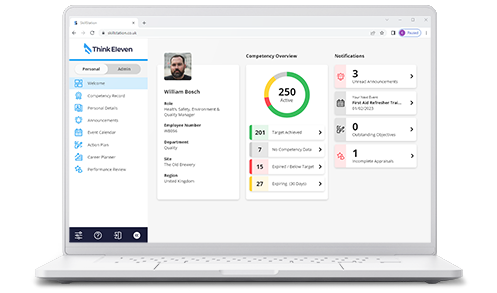Workforce Planning
Right people, right place, at the right time

What is Workforce Planning?
Workforce planning (also known as strategic workforce planning) is the utilisation of a strategic long-term view to ensure that you have the right skills and capability to deliver your organisational objectives.
One thing is for sure - change is guaranteed. It is vitally important that your organisation has a plan to ensure that your people (workforce) are both optimised and fit-for-purpose for today's requirements as well as future requirements.
Your sector, service and/or product will influence how far it is reasonable to look ahead. Look too far ahead and there's an increased level of uncertainty in any plan/forecast.
It’s common for organisations to have a product, service or technical roadmap that looks 3 to 5 years ahead. However, there’s often a disconnect between this and the people planning to support the delivery. This is where Strategic Workforce Planning come into effect.
PESTEL
Key considerations when looking at your workforce plan are the external influences and risks:
- Political
- What macro or micro political considerations may affect your market, product or service?
- Economic
- What macro or micro economic considerations may affect your market, product or service e.g. Crypto currencies becoming mainstream?
- Social
- What macro or micro social considerations affect your market, product or service e.g. a complete rejection of plastics?
- Technological
- Is the pace of technological change and the emergence of disruptive technologies a consideration or risk/opportunity to your business model?
- Environmental
- Are there any environmental risks or opportunities emerging that you can leverage value from?
- Legal
- Is there any regulation or legislation that could impact your product or service in the longer-term?
Competitor Analysis
The above does not include the emergence of new competitors within your local or global market, but this should also be a key consideration.
Effective workforce planning offers numerous advantages for organisations:
- Strategic Alignment: By taking a proactive and longer-term approach to managing people, knowledge, skills, capacity, and capability, organisations can ensure alignment with strategic objectives and plans. This strategic alignment enables organisations to stay ahead of evolving market trends e.g. technological change and maintain a competitive edge.
- Risk Mitigation: Effective workforce planning helps organisations identify and mitigate potential risks by developing the necessary capabilities within the workforce. By anticipating future needs and challenges, organisations can proactively address emerging skill gaps, succession issues, and other potential obstacles to success.
- Enhanced Organisational Agility: A well-planned workforce is agile and adaptable, capable of responding swiftly to changing business dynamics and market conditions. This agility enables organisations to seize opportunities, overcome challenges, and navigate uncertainty with confidence.
- Optimised Resource Utilisation: Workforce planning ensures that resources, including talent, are deployed efficiently and effectively to meet organisational goals. By optimising resource utilisation, organisations can enhance productivity, reduce costs, and drive sustainable growth.
- Talent Development: Workforce planning facilitates talent development by identifying opportunities for skills enhancement, career advancement, and professional growth. This focus on talent development fosters employee engagement, retention, and satisfaction, leading to a more resilient and high-performing workforce.
By embracing effective workforce planning practices, organisations can position themselves for long-term success, ensuring they have the right people with the right skills in the right place at the right time to achieve their strategic objectives and drive sustainable growth.
A short-term or reactive view will limit your success, especially if you operate in a fast-paced environment and market e.g. Information Technology. The pace of change will affect the range of skills, knowledge and overall capability that you will require to remain competitive within your chosen market.
People have to be at the heart of this process. The knowledge, skills and capabilities that you have today are likely to be different to those required in 5, 10 and 15 years’ time. Things to consider that will affect your Workforce Planning are:
Workforce Age Profile
You may have a high proportion of your workforce with an age profile to the right-side of the bell curve (approaching retirement)
Knowledge Transfer
Do you have an effective knowledge transfer process to ensure the knowledge, skills and experience is transferred to the younger and emerging talent pool?
Equality & Gender Balance
It’s proven that diverse teams are more productive, so how do you recruit and develop a more diverse workforce?
Succession Planning
Replace those who retire or exit the business early. You may also have subject matter experts and single point failures in terms of people who present a risk if they leave.
Technological Change
The pace of change in this area is accelerating. It’s therefore hugely important that you are:
- Developing and up-skilling your existing talent pool.
- Looking at the future talent pool e.g. school leavers, A-Level/Higher students, undergraduates, graduates and post-graduates with the right education and qualifications.
- Engaging with academia and wider stakeholders in the area of skills and education to ensure the talent pool is being taught and trained in the latest technologies.
- Leadership & Management
Not to be forgotten, and possibly the most important roles and functions in any organisation. Ensuring that you are identifying and developing world-class leadership and management skills to sustain and grow your organisations future.
We can support and facilitate your approach. We have experience in helping organisations develop and review a long-term competency framework.
SkillStation can provide you with key data to assist with your workforce planning.
With the right approach over a suitable time period, any organisation can mitigate the risk of change, safeguard against potential adverse effects, and more importantly use these to your competitive advantage. Whilst others react to change, you are in control and have planned your way through any disruption that presents itself.
